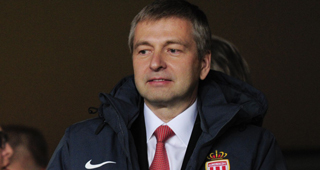It began with the grandest of ambitions.
When Dmitry Rybolovlev bought a majority stake of AS Monaco in December 2011, the archetype was already set: billionaire buys football club, breaks transfer records for attackers, and builds a top heavy team that wins domestic titles on sheer power. It was even better that the club were in Ligue 2 at the time. Billionaires are supposed to have a sixth sense in buying low.
Rybolovlev followed the path for a time. In the summer of 2013, he broke the French league transfer record with his purchase of Falcao from Atlético Madrid, then double swooped on Joao Moutinho and James Rodriguez from FC Porto. Monaco was building an attacking team that matched the glamour of the casino town.
That was the theory, anyway. The following two seasons brought a combination of financial restrictions, a dazzling World Cup performance, and perhaps the savviest billionaire owner in Europe to get to where Monaco are today: the quarterfinals of the Champions League.
There is also the theory that constraints are a requirement of true creativity. Ryblolovlev was hampered by both Financial Fair Play rules and an internal examination of the future of French soccer if led by the Monaco model of gathering expensive foreign transfers. It’s an identity crisis familiar with Premier League fans. The French media have suggested an alternative: Monaco could build their dream team, but only with top French players.
The introspection resulted in Monaco behaving more like a club with a tenth of its financial resources with an emphasis on promoting its underrated youth academy. James Rodriguez was sold last summer to Real Madrid, with Falcao going on loan to Manchester United. Manager Claudio Ranieri was let go, replaced by Portuguese manager Leonardo Jardim.
What remained was the backbone of a midfield in Jeremy Toulalan and Moutinho. The duo fit classic roles – Toulalan the holder and Moutinho the playmaker. Alongside them fit 22-year-old Geoffrey Kondogbia as runner and destroyer.
One summer later, Monaco balanced their midfield. And they also had their youth.
Priceless Youth
At its core, Monaco strategies are simple: Toulalan and Kondogbia control the midfield while Moutinho and width create chances for Dimitar Berbatov. It’s a formula overly reliant on the individual brilliance of its youth, as the side have only scored 35 goals in the league (compared to 55 for league leaders PSG). But they’ve also given up the fewest amount of goals in the league, and only seven goals with 11 clean sheets in 2015. Its stinginess works better in knock out competitions than league play itself (Monaco currently are in fourth place).
Tim Vickery observed that South American soccer has an age donut where players are either young and on their way to Europe, or older and on their way back from Europe, and thus lacking players in their prime. Monaco’s attack is an “age donut” masterfully blended. There’s the veteran savvy of the 34-year-old Berbatov, 28-year-old Moutinho, and 29-year-old Nabil Dirar. The experience is flanked by the running of 19-year-old Anthony Martial, 20-year-old Bernando Silva, and 21-year-old gem Yannick Ferreira Carrasco on the wing.
While their youth may lack the ingenuity to break down a parked bus (hence their low return on goals), their speed and adventurousness is perfect for high European defensive lines, leading to counter attacking goals like Berbatov’s second against Arsenal in which the team went the full field in some 11 seconds.
That goal was different from Monaco’s first goal, in which the ball was won in Arsenal’s own half by 21-year-old right back Fabinho. Three passes later, Kondogbia got lucky with a deflection. The quickness was inherently modern. Orchestrating that was a manager who cut his teeth Portugal.
Jardim Finds His Team
Building a championship team is no perfect line, and Leonardo Jardim may not have found himself in the position of Monaco manager had their original spending spree continued.
Jardim came from Sporting Lisbon last summer in controversy. Previous manager Claudio Ranieri lead Monaco to a club record point total. Jardim’s previous biggest club experience was Olympiacos, for which he was fired after 22 matches.
But upon closer look, Rybolovlev’s decision reveals a Moneyball-esque savvy to hire a manager not on name, but on fitting a philosophy (this lead articles about whether he actually knew what he was doing). Jardim’s C.V. reads like both a best-and-worst-of Portugal domestic league jobs, from AD Camacha to Chaves to Braga.
The structure of Monaco is reminiscent of Sporting and other Portuguese sides, with young attacking talent flanked by veterans. This time, however, Jardim has the finances behind him to hold onto his phenoms. The answer to “what if Porto and Sporting Lisbon let their young talent develop as a team?” might be found in Ligue 1 over the next several years.
The last time Monaco were relevant in Europe was also the last time a team outside of the big four leagues was in the finals. In 2004, the club lost to FC Porto, who was lead by a 40 year old Portuguese manager driven by a balanced, three man midfield lacking big names. If nothing else, Jardim has Mourinho’s touchline celebration down.
It would have been easy to snicker at Monaco two seasons ago as they sat in Ligue 2 with their billionaire owner. In an unexpected move, they ran like a club with a fraction its means in its frugality and youth development, featuring buzzwords like sustainability. As a result, Rybolovlev found something money can’t buy – an European identity.



